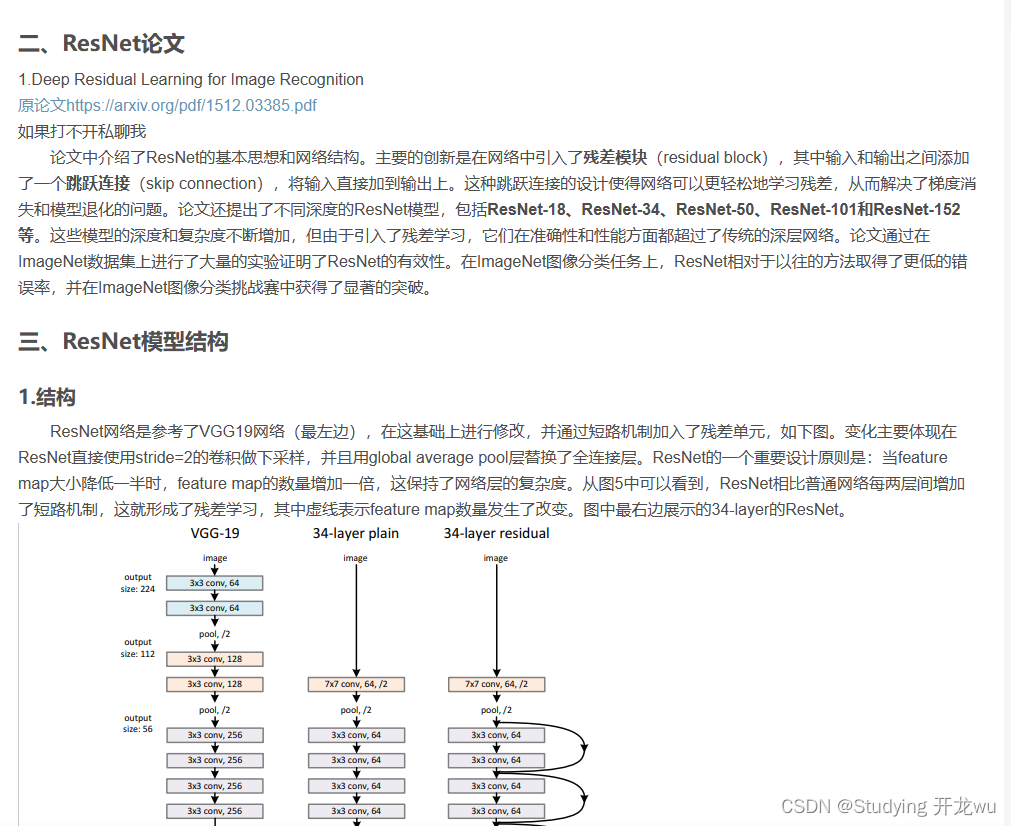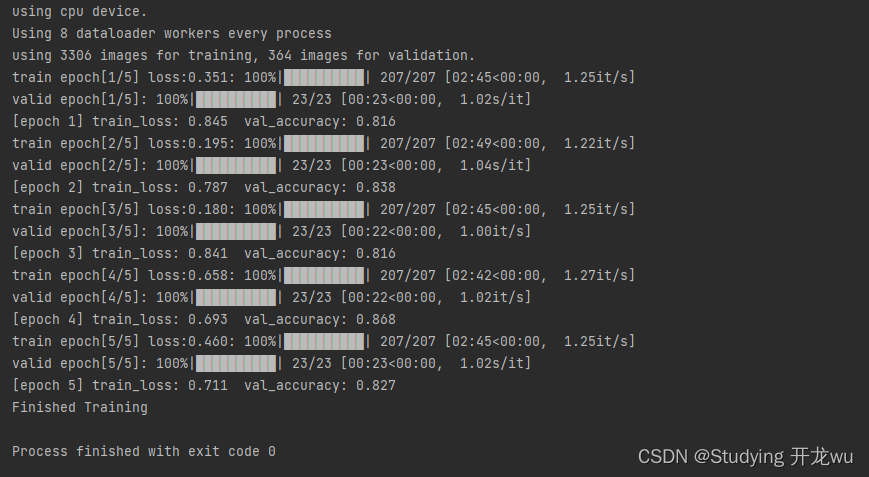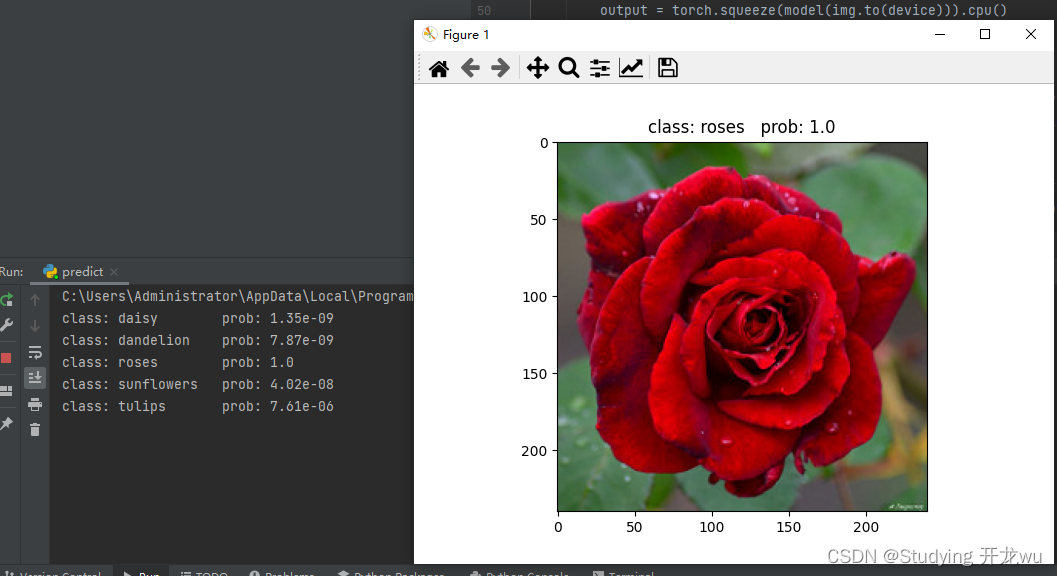- 1关于windows安全权限_d盘user默认权限
- 2android交叉编译C++代码_android-ndk-r23 sysroot目录在哪
- 3c语言字符串复制两种方法,字符串复制的几种方法
- 4怎样优雅地增删查改(三):业务用户的增数据结构就下面几个删查改
- 5打包部署若依SpringBoot后端和Vue前端_若依前端打包命令
- 6Android Studio运行项目闪退_android studio的虚拟机一运行项目就闪退
- 7微信小程序、uniapp自定义底部导航栏(附源码)_uniapp 使用 自定义底部导航
- 8STM32CubeMX实战教程(四)——基本定时器(还是点灯)
- 9关联规则之序列模式挖掘--GSP算法
- 10HTML~_报错
深度学习pytorch实战五:基于ResNet34迁移学习的方法图像分类篇自建花数据集图像分类(5类)超详细代码_resnet34图像分类
赞
踩
1.数据集简介
2.模型相关知识
3.split_data.py——训练集与测试集划分
4.model.py——定义ResNet34网络模型
5.train.py——加载数据集并训练,训练集计算损失值loss,测试集计算accuracy,保存训练好的网络参数
6.predict.py——利用训练好的网络参数后,用自己找的图像进行分类测试
一、数据集简介
1.自建数据文件夹
首先确定这次分类种类,采用爬虫、官网数据集和自己拍照的照片获取5类,新建个文件夹data,里面包含5个文件夹,文件夹名字取种类英文,每个文件夹照片数量最好一样多,五百多张以上。如我选了雏菊,蒲公英,玫瑰,向日葵,郁金香5类,如下图,每种类型有600~900张图像。如下图
花数据集下载链接https://storage.googleapis.com/download.tensorflow.org/example_images/flower_photos.tgz

2.划分训练集与测试集
这是划分数据集代码,同一目录下运,复制改文件夹路径。
import os from shutil import copy import random def mkfile(file): if not os.path.exists(file): os.makedirs(file) # 获取 photos 文件夹下除 .txt 文件以外所有文件夹名(即3种分类的类名) file_path = 'data/flower_photos' flower_class = [cla for cla in os.listdir(file_path) if ".txt" not in cla] # 创建 训练集train 文件夹,并由3种类名在其目录下创建3个子目录 mkfile('flower_data/train') for cla in flower_class: mkfile('flower_data/train/' + cla) # 创建 验证集val 文件夹,并由3种类名在其目录下创建3个子目录 mkfile('flower_data/val') for cla in flower_class: mkfile('flower_data/val/' + cla) # 划分比例,训练集 : 验证集 = 9 : 1 split_rate = 0.1 # 遍历3种花的全部图像并按比例分成训练集和验证集 for cla in flower_class: cla_path = file_path + '/' + cla + '/' # 某一类别动作的子目录 images = os.listdir(cla_path) # iamges 列表存储了该目录下所有图像的名称 num = len(images) eval_index = random.sample(images, k=int(num * split_rate)) # 从images列表中随机抽取 k 个图像名称 for index, image in enumerate(images): # eval_index 中保存验证集val的图像名称 if image in eval_index: image_path = cla_path + image new_path = 'flower_data/val/' + cla copy(image_path, new_path) # 将选中的图像复制到新路径 # 其余的图像保存在训练集train中 else: image_path = cla_path + image new_path = 'flower_data/train/' + cla copy(image_path, new_path) print("\r[{}] processing [{}/{}]".format(cla, index + 1, num), end="") # processing bar print() print("processing done!")
- 1
- 2
- 3
- 4
- 5
- 6
- 7
- 8
- 9
- 10
- 11
- 12
- 13
- 14
- 15
- 16
- 17
- 18
- 19
- 20
- 21
- 22
- 23
- 24
- 25
- 26
- 27
- 28
- 29
- 30
- 31
- 32
- 33
- 34
- 35
- 36
- 37
- 38
- 39
- 40
- 41
- 42
- 43
- 44
- 45
- 46
- 47
- 48
- 49
- 50
二、模型相关知识
之前有文章介绍模型,如果不清楚可以点下链接转过去学习。
深度学习卷积神经网络CNN之ResNet模型网络详解说明(超详细理论篇)

三、model.py——定义ResNet34网络模型
这里还是直接复制给出原模型,不用改参数。模型包含34、50、101模型
import torch.nn as nn import torch class BasicBlock(nn.Module): expansion = 1 def __init__(self, in_channel, out_channel, stride=1, downsample=None, **kwargs): super(BasicBlock, self).__init__() self.conv1 = nn.Conv2d(in_channels=in_channel, out_channels=out_channel, kernel_size=3, stride=stride, padding=1, bias=False) self.bn1 = nn.BatchNorm2d(out_channel) self.relu = nn.ReLU() self.conv2 = nn.Conv2d(in_channels=out_channel, out_channels=out_channel, kernel_size=3, stride=1, padding=1, bias=False) self.bn2 = nn.BatchNorm2d(out_channel) self.downsample = downsample def forward(self, x): identity = x if self.downsample is not None: identity = self.downsample(x) out = self.conv1(x) out = self.bn1(out) out = self.relu(out) out = self.conv2(out) out = self.bn2(out) out += identity out = self.relu(out) return out class Bottleneck(nn.Module): """ 注意:原论文中,在虚线残差结构的主分支上,第一个1x1卷积层的步距是2,第二个3x3卷积层步距是1。 但在pytorch官方实现过程中是第一个1x1卷积层的步距是1,第二个3x3卷积层步距是2, 这么做的好处是能够在top1上提升大概0.5%的准确率。 可参考Resnet v1.5 https://ngc.nvidia.com/catalog/model-scripts/nvidia:resnet_50_v1_5_for_pytorch """ expansion = 4 def __init__(self, in_channel, out_channel, stride=1, downsample=None, groups=1, width_per_group=64): super(Bottleneck, self).__init__() width = int(out_channel * (width_per_group / 64.)) * groups self.conv1 = nn.Conv2d(in_channels=in_channel, out_channels=width, kernel_size=1, stride=1, bias=False) # squeeze channels self.bn1 = nn.BatchNorm2d(width) # ----------------------------------------- self.conv2 = nn.Conv2d(in_channels=width, out_channels=width, groups=groups, kernel_size=3, stride=stride, bias=False, padding=1) self.bn2 = nn.BatchNorm2d(width) # ----------------------------------------- self.conv3 = nn.Conv2d(in_channels=width, out_channels=out_channel*self.expansion, kernel_size=1, stride=1, bias=False) # unsqueeze channels self.bn3 = nn.BatchNorm2d(out_channel*self.expansion) self.relu = nn.ReLU(inplace=True) self.downsample = downsample def forward(self, x): identity = x if self.downsample is not None: identity = self.downsample(x) out = self.conv1(x) out = self.bn1(out) out = self.relu(out) out = self.conv2(out) out = self.bn2(out) out = self.relu(out) out = self.conv3(out) out = self.bn3(out) out += identity out = self.relu(out) return out class ResNet(nn.Module): def __init__(self, block, blocks_num, num_classes=1000, include_top=True, groups=1, width_per_group=64): super(ResNet, self).__init__() self.include_top = include_top self.in_channel = 64 self.groups = groups self.width_per_group = width_per_group self.conv1 = nn.Conv2d(3, self.in_channel, kernel_size=7, stride=2, padding=3, bias=False) self.bn1 = nn.BatchNorm2d(self.in_channel) self.relu = nn.ReLU(inplace=True) self.maxpool = nn.MaxPool2d(kernel_size=3, stride=2, padding=1) self.layer1 = self._make_layer(block, 64, blocks_num[0]) self.layer2 = self._make_layer(block, 128, blocks_num[1], stride=2) self.layer3 = self._make_layer(block, 256, blocks_num[2], stride=2) self.layer4 = self._make_layer(block, 512, blocks_num[3], stride=2) if self.include_top: self.avgpool = nn.AdaptiveAvgPool2d((1, 1)) # output size = (1, 1) self.fc = nn.Linear(512 * block.expansion, num_classes) for m in self.modules(): if isinstance(m, nn.Conv2d): nn.init.kaiming_normal_(m.weight, mode='fan_out', nonlinearity='relu') def _make_layer(self, block, channel, block_num, stride=1): downsample = None if stride != 1 or self.in_channel != channel * block.expansion: downsample = nn.Sequential( nn.Conv2d(self.in_channel, channel * block.expansion, kernel_size=1, stride=stride, bias=False), nn.BatchNorm2d(channel * block.expansion)) layers = [] layers.append(block(self.in_channel, channel, downsample=downsample, stride=stride, groups=self.groups, width_per_group=self.width_per_group)) self.in_channel = channel * block.expansion for _ in range(1, block_num): layers.append(block(self.in_channel, channel, groups=self.groups, width_per_group=self.width_per_group)) return nn.Sequential(*layers) def forward(self, x): x = self.conv1(x) x = self.bn1(x) x = self.relu(x) x = self.maxpool(x) x = self.layer1(x) x = self.layer2(x) x = self.layer3(x) x = self.layer4(x) if self.include_top: x = self.avgpool(x) x = torch.flatten(x, 1) x = self.fc(x) return x def resnet34(num_classes=1000, include_top=True): # https://download.pytorch.org/models/resnet34-333f7ec4.pth return ResNet(BasicBlock, [3, 4, 6, 3], num_classes=num_classes, include_top=include_top) def resnet50(num_classes=1000, include_top=True): # https://download.pytorch.org/models/resnet50-19c8e357.pth return ResNet(Bottleneck, [3, 4, 6, 3], num_classes=num_classes, include_top=include_top) def resnet101(num_classes=1000, include_top=True): # https://download.pytorch.org/models/resnet101-5d3b4d8f.pth return ResNet(Bottleneck, [3, 4, 23, 3], num_classes=num_classes, include_top=include_top) def resnext50_32x4d(num_classes=1000, include_top=True): # https://download.pytorch.org/models/resnext50_32x4d-7cdf4587.pth groups = 32 width_per_group = 4 return ResNet(Bottleneck, [3, 4, 6, 3], num_classes=num_classes, include_top=include_top, groups=groups, width_per_group=width_per_group) def resnext101_32x8d(num_classes=1000, include_top=True): # https://download.pytorch.org/models/resnext101_32x8d-8ba56ff5.pth groups = 32 width_per_group = 8 return ResNet(Bottleneck, [3, 4, 23, 3], num_classes=num_classes, include_top=include_top, groups=groups, width_per_group=width_per_group)
- 1
- 2
- 3
- 4
- 5
- 6
- 7
- 8
- 9
- 10
- 11
- 12
- 13
- 14
- 15
- 16
- 17
- 18
- 19
- 20
- 21
- 22
- 23
- 24
- 25
- 26
- 27
- 28
- 29
- 30
- 31
- 32
- 33
- 34
- 35
- 36
- 37
- 38
- 39
- 40
- 41
- 42
- 43
- 44
- 45
- 46
- 47
- 48
- 49
- 50
- 51
- 52
- 53
- 54
- 55
- 56
- 57
- 58
- 59
- 60
- 61
- 62
- 63
- 64
- 65
- 66
- 67
- 68
- 69
- 70
- 71
- 72
- 73
- 74
- 75
- 76
- 77
- 78
- 79
- 80
- 81
- 82
- 83
- 84
- 85
- 86
- 87
- 88
- 89
- 90
- 91
- 92
- 93
- 94
- 95
- 96
- 97
- 98
- 99
- 100
- 101
- 102
- 103
- 104
- 105
- 106
- 107
- 108
- 109
- 110
- 111
- 112
- 113
- 114
- 115
- 116
- 117
- 118
- 119
- 120
- 121
- 122
- 123
- 124
- 125
- 126
- 127
- 128
- 129
- 130
- 131
- 132
- 133
- 134
- 135
- 136
- 137
- 138
- 139
- 140
- 141
- 142
- 143
- 144
- 145
- 146
- 147
- 148
- 149
- 150
- 151
- 152
- 153
- 154
- 155
- 156
- 157
- 158
- 159
- 160
- 161
- 162
- 163
- 164
- 165
- 166
- 167
- 168
- 169
- 170
- 171
- 172
- 173
- 174
- 175
- 176
- 177
- 178
- 179
- 180
- 181
- 182
- 183
- 184
- 185
- 186
- 187
- 188
- 189
- 190
- 191
- 192
- 193
- 194
- 195
- 196
- 197
- 198
- 199
四、train.py——训练,计算损失值loss,计算accuracy,保存训练好的网络参数
第一步,提前下载权重链接,复制链接网址打开直接下载,下载完,放在同一个工程文件夹,记得修改个名字,后面要用。
ResNet34权重链接https://download.pytorch.org/models/resnet34-333f7ec4.pth
第二步 71行类数、63行之前下载权重文件名字、83行保存最终权重文件名字
net.fc = nn.Linear(in_channel, 5)//修改5类的5
- 1
model_weight_path = "./resnet34-pre.pth"
- 1
save_path = './resNext34.pth'
- 1
其他参数bach_size=16;(根据cpu或GPU性能选择32、64等)
学习率 0.01
epoch 5
import os import sys import json import torch import torch.nn as nn import torch.optim as optim from torchvision import transforms, datasets from tqdm import tqdm from model import resnet34,resnet101 def main(): device = torch.device("cuda:0" if torch.cuda.is_available() else "cpu") print("using {} device.".format(device)) data_transform = { "train": transforms.Compose([transforms.RandomResizedCrop(224), transforms.RandomHorizontalFlip(), transforms.ToTensor(), transforms.Normalize([0.485, 0.456, 0.406], [0.229, 0.224, 0.225])]), "val": transforms.Compose([transforms.Resize(256), transforms.CenterCrop(224), transforms.ToTensor(), transforms.Normalize([0.485, 0.456, 0.406], [0.229, 0.224, 0.225])])} data_root = os.path.abspath(os.path.join(os.getcwd(), "../..")) # get data root path image_path = os.path.join(data_root, "zjdata", "flower_data") # flower data set path assert os.path.exists(image_path), "{} path does not exist.".format(image_path) train_dataset = datasets.ImageFolder(root=os.path.join(image_path, "train"), transform=data_transform["train"]) train_num = len(train_dataset) # {'daisy':0, 'dandelion':1, 'roses':2, 'sunflower':3, 'tulips':4} flower_list = train_dataset.class_to_idx cla_dict = dict((val, key) for key, val in flower_list.items()) # write dict into json file json_str = json.dumps(cla_dict, indent=4) with open('class_indices.json', 'w') as json_file: json_file.write(json_str) batch_size = 16 nw = min([os.cpu_count(), batch_size if batch_size > 1 else 0, 8]) # number of workers print('Using {} dataloader workers every process'.format(nw)) train_loader = torch.utils.data.DataLoader(train_dataset, batch_size=batch_size, shuffle=True, num_workers=nw) validate_dataset = datasets.ImageFolder(root=os.path.join(image_path, "val"), transform=data_transform["val"]) val_num = len(validate_dataset) validate_loader = torch.utils.data.DataLoader(validate_dataset, batch_size=batch_size, shuffle=False, num_workers=nw) print("using {} images for training, {} images for validation.".format(train_num, val_num)) net = resnet34() # load pretrain weights # download url: https://download.pytorch.org/models/resnet34-333f7ec4.pth model_weight_path = "./resnet34-pre.pth" assert os.path.exists(model_weight_path), "file {} does not exist.".format(model_weight_path) net.load_state_dict(torch.load(model_weight_path, map_location='cpu')) for param in net.parameters(): param.requires_grad = False # change fc layer structure in_channel = net.fc.in_features net.fc = nn.Linear(in_channel, 5) net.to(device) # define loss function loss_function = nn.CrossEntropyLoss() # construct an optimizer params = [p for p in net.parameters() if p.requires_grad] optimizer = optim.Adam(params, lr=0.01) epochs = 5 best_acc = 0.0 save_path = './resNext34.pth' train_steps = len(train_loader) for epoch in range(epochs): # train net.train() running_loss = 0.0 train_bar = tqdm(train_loader, file=sys.stdout) for step, data in enumerate(train_bar): images, labels = data optimizer.zero_grad() logits = net(images.to(device)) loss = loss_function(logits, labels.to(device)) loss.backward() optimizer.step() # print statistics running_loss += loss.item() train_bar.desc = "train epoch[{}/{}] loss:{:.3f}".format(epoch + 1, epochs, loss) # validate net.eval() acc = 0.0 # accumulate accurate number / epoch with torch.no_grad(): val_bar = tqdm(validate_loader, file=sys.stdout) for val_data in val_bar: val_images, val_labels = val_data outputs = net(val_images.to(device)) # loss = loss_function(outputs, test_labels) predict_y = torch.max(outputs, dim=1)[1] acc += torch.eq(predict_y, val_labels.to(device)).sum().item() val_bar.desc = "valid epoch[{}/{}]".format(epoch + 1, epochs) val_accurate = acc / val_num print('[epoch %d] train_loss: %.3f val_accuracy: %.3f' % (epoch + 1, running_loss / train_steps, val_accurate)) if val_accurate > best_acc: best_acc = val_accurate torch.save(net.state_dict(), save_path) print('Finished Training') if __name__ == '__main__': main()
- 1
- 2
- 3
- 4
- 5
- 6
- 7
- 8
- 9
- 10
- 11
- 12
- 13
- 14
- 15
- 16
- 17
- 18
- 19
- 20
- 21
- 22
- 23
- 24
- 25
- 26
- 27
- 28
- 29
- 30
- 31
- 32
- 33
- 34
- 35
- 36
- 37
- 38
- 39
- 40
- 41
- 42
- 43
- 44
- 45
- 46
- 47
- 48
- 49
- 50
- 51
- 52
- 53
- 54
- 55
- 56
- 57
- 58
- 59
- 60
- 61
- 62
- 63
- 64
- 65
- 66
- 67
- 68
- 69
- 70
- 71
- 72
- 73
- 74
- 75
- 76
- 77
- 78
- 79
- 80
- 81
- 82
- 83
- 84
- 85
- 86
- 87
- 88
- 89
- 90
- 91
- 92
- 93
- 94
- 95
- 96
- 97
- 98
- 99
- 100
- 101
- 102
- 103
- 104
- 105
- 106
- 107
- 108
- 109
- 110
- 111
- 112
- 113
- 114
- 115
- 116
- 117
- 118
- 119
- 120
- 121
- 122
- 123
- 124
- 125
- 126
- 127
- 128
- 129
- 130
- 131
- 132
- 133
训练开始截图,我是用CPU训练

六、predict.py——利用训练好的网络参数后,用自己找的图像进行分类测试
注意图片位置和权重参数名字
import os import json import torch from PIL import Image from torchvision import transforms import matplotlib.pyplot as plt from model import resnet34 def main(): device = torch.device("cuda:0" if torch.cuda.is_available() else "cpu") data_transform = transforms.Compose( [transforms.Resize(256), transforms.CenterCrop(224), transforms.ToTensor(), transforms.Normalize([0.485, 0.456, 0.406], [0.229, 0.224, 0.225])]) # load image img_path = "./1.jpg" assert os.path.exists(img_path), "file: '{}' dose not exist.".format(img_path) img = Image.open(img_path) plt.imshow(img) # [N, C, H, W] img = data_transform(img) # expand batch dimension img = torch.unsqueeze(img, dim=0) # read class_indict json_path = './class_indices.json' assert os.path.exists(json_path), "file: '{}' dose not exist.".format(json_path) with open(json_path, "r") as f: class_indict = json.load(f) # create model model = resnet34(num_classes=5).to(device) # load model weights weights_path = "./resNext34.pth" assert os.path.exists(weights_path), "file: '{}' dose not exist.".format(weights_path) model.load_state_dict(torch.load(weights_path, map_location=device)) # prediction model.eval() with torch.no_grad(): # predict class output = torch.squeeze(model(img.to(device))).cpu() predict = torch.softmax(output, dim=0) predict_cla = torch.argmax(predict).numpy() print_res = "class: {} prob: {:.3}".format(class_indict[str(predict_cla)], predict[predict_cla].numpy()) plt.title(print_res) for i in range(len(predict)): print("class: {:10} prob: {:.3}".format(class_indict[str(i)], predict[i].numpy())) plt.show() if __name__ == '__main__': main()
- 1
- 2
- 3
- 4
- 5
- 6
- 7
- 8
- 9
- 10
- 11
- 12
- 13
- 14
- 15
- 16
- 17
- 18
- 19
- 20
- 21
- 22
- 23
- 24
- 25
- 26
- 27
- 28
- 29
- 30
- 31
- 32
- 33
- 34
- 35
- 36
- 37
- 38
- 39
- 40
- 41
- 42
- 43
- 44
- 45
- 46
- 47
- 48
- 49
- 50
- 51
- 52
- 53
- 54
- 55
- 56
- 57
- 58
- 59
- 60
- 61
- 62
- 63
- 64
- 65
预测结果截图




